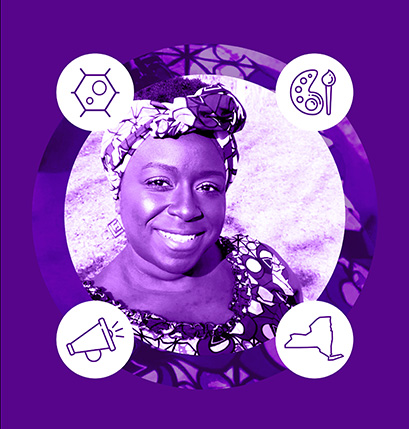Joy Sanga has been a middle school science educator for 12 years. When she decided to pursue the NYU Teacher Residency, she had nine years of experience teaching in New York City. Why would an experienced teacher seek out the Teacher Residency?
For Joy, the previous years in teaching taught her that the one constant was change. Her ability to adapt to change correlated with her ability to improve as an educator. The Teacher Residency gave Joy new approaches to tackle challenges and remain flexible. “Every year is different. I learn more and more to be prepared for change and comfortable to shift my lessons and approaches depending on my students.”
During the first year of her career, she began a master’s program. “I started a master’s in 2009, and I just couldn’t be a full-time teacher and a full-time student. By 2018, I was in a different space.”
The Teacher Residency model controls for what Joy described as being “thrown to the wolves” during her initial years of teaching. The program design – purposeful immersion into teaching and the gradual release of responsibility throughout the year – ensures that teacher residents are not too consumed by learning to teach while on the job full time. These training features are effective for an aspiring teacher or an experienced educator.
Teaching is about relationships
At this stage in her career, Joy knows that relationships are paramount to improve student success. “Relationships are different each year. Every new class requires a transition. What helps is to talk to your colleagues who may have had your students in the past. You can really learn a lot about how to approach each student based on who they are and what they need.”
Joy found new strategies to build meaningful relationships with students through the Teacher Residency. The Participatory Action Research (PAR) project requirement stood out for the way it provides long-lasting tools to create community in her classrooms. During the capstone PAR project, Joy acted as a teacher researcher and worked with students as the PAR team to identify their problem of practice.
“Initially, I wanted to explore the problem of the difference between how boys and girls are treated in class,” explained Joy. “So I issued students an anonymous quiz, and they responded that this was not the problem that they witnessed. What they did see and feel is that schools give the most attention to the squeakiest wheels; the students who didn’t do the right thing get a lot of attention.”
Joy immediately saw the objective of the PAR project. Instead of solely determining the problems in her own classroom, she learned that students need an opportunity to weigh in on the issues they experience.
“The kids came up with the Shout-Out Squad. Our eighth-graders would shout out other eighth-graders who did good deeds or made an impact. What we learned about was true allyship and advocacy and how to create space for others to have their voices heard.”
The PAR experience provided Joy a new outlook on student-centered classrooms: “It’s essential to think about the ways that we can give students agency and actual steps to move into leadership positions.”
Impact through authenticity
Knowing how to foster positive classroom relationships is a two-way street between a teacher and a student. “Early in my teaching career, I tried to appeal to the masses. NYU Steinhardt did a really good job to help me think about building authenticity,” Joy added. She knows that she must bring her true self to the classroom each and every day.
Joy would occasionally express interest in activities that she wasn’t truly fond of in an attempt to relate to her students. “I am now okay with saying, ‘I like watercolor painting. Who wants to paint with me?’ or I will bring in my favorite board games and see who wants to play at lunch.”
What comes with this authenticity is also a recognition of what students bring to the table. Joy consistently notes that teachers do not know everything. She offers some sage advice: “Give kids space to teach you things that you don’t know. And remember, kids are hilariously honest.”
It is critically important to listen and let students share in order to create a positive classroom culture. Joy mentioned that teachers and students are individuals and should be treated that way. “I always try to remember that content is secondary to humanity. NYU Steinhardt gave me more tools to focus on who kids are as people, not just as students in my classroom.”
Growth mindset and continual improvement
After several years teaching and the Teacher Residency, where she honed her unique pedagogy and expertise in her content area, Joy now focuses on the evolution of her practice. Her advice to others: “Steal everything you can from other teachers. Your colleagues are a source of vast information. Do not ever feel like you need to have all the answers. You do not continually improve alone.”
Teaching is dynamic. Joy acknowledges that each year is different, which provides her with a new sense of calm about the profession. “If you change things up each year, it may feel like your first year again. Be okay with that.” She knows that if days feel difficult or uncomfortable, it is probably because she’s doing something right to improve the learning environment for her students.
Joy’s growth mindset helps her thrive. The Teacher Residency provided her an opportunity to reflect on and delve deeper into her practice. For an experienced educator like Joy, this program can help one sharpen skills and techniques – such as different ways to build meaningful relationships with students and focus on them as individuals – and make an even greater impact on the lives of students.
